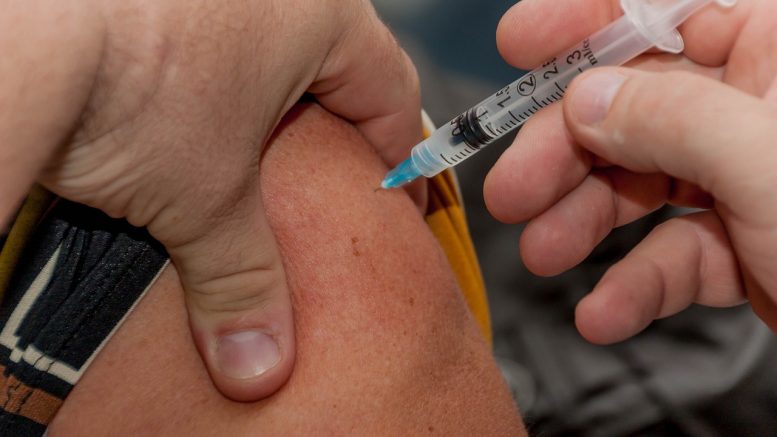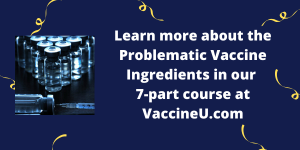By Heather Simpson, Vaxxter Contributor
In 1986, Congress passed a law that gave vaccine manufacturers freedom from liability for their dirty products. Health and Human Services (HHS), through the FDA, was given the responsibility to test all vaccines for safety prior to approval and release. Congress knew that pharmaceutical companies would not police their own behavior. Therefore, the law included a clause that required that they report to Congress approximately every two years to show how they were making vaccines safer.
In November 2018, a lawsuit filed – and won – by RFK Jr. in conjunction with Del Bigtree’s organization, Informed Consent Action Network (ICAN) found that not a single report had been filed in more than 30 years. Independent scientists continue to expose the toxicity of a long list of dangerous substances in vaccines, including thimerosal (preservative), polysorbate 80 (emulsifier), triton X-100 (detergent/surfactant), and fetal DNA ( MRC-5, WI-38), bovine serum, chicken proteins, antibiotics and adjuvants (aluminum, squalene, MF59).
Not only have they not taken any steps to make vaccines safer, the new adjuvants being developed may be the most toxic ingredients of all.
WHAT IS AN ADJUVANT?
Vaccine adjuvants were first described more than 90 years ago. An adjuvant is
A product or component, or association of components, either natural or synthetic, that enhances the immune response against an antigen. An adjuvant is essential to stimulate an antibody respose.
Adjuvants increase the amount of antibodies produced, extending the duration of the immune response. Furthermore, adjuvants also allow pharmaceutical companies to reduce the amount of antigen (virus or bacteria) used on the vaccine, reducing production costs.
By definition, adjuvants are considered to be pharmacologically active drugs. They are designed to be inert without inherent activity or toxicity and yet they are required to potently augment the response of the immune system. It is difficult to explain how a substance can be defined as “pharmacologically active” and at the same time be designed to be “inert and have no activity or toxicity.”
Aluminum was first used as an adjuvant in the diphtheria vaccine in 1932. Even though aluminum is highly toxic, bio-persistent and can be carried across the blood-brain barrier by macrophages, it is currently the only FDA-approved adjuvant in the US. Aluminum has been associated with many chronic illnesses including autoimmunity, autism and macrophagic myofasciitis (MMF).
Most of the vaccines in the schedule contain aluminum as an adjuvant. It accumulates in the body over time. Aluminum has been found in the brain cells autistic people by Dr. Chris Exley. Pediatricians who tell parents that the amount of aluminum is inconsequential obviously don’t know that a fully vaccinated child will be injected with 4925 micrograms of aluminum by 18 months of age.
Professor Exley from Keele University in the UK explains in this recent study.
On day 56 of life, infant who receives a single dose of Infanrix Hexa (DTaP + polio + hepatitis B + HiB) receives 820 mcg. of aluminium. A single dose of this vaccine is equivalent to the exposure to aluminum an infant would receive from 150 days breast-feeding. It is equal to 25 times the daily dose of aluminum received from the most contaminated of infant formulas. It is also highly relevant that other aluminum adjuvanted vaccines, for example, Prevenar 13 with 125 mcg. of aluminum and Men B, with 500 mcg. of aluminum, are also part of the infant vaccine schedule (in the UK) during this same period.
Do the math: That is at least 1,332 mcg of aluminum injected during a crucial time of brain development. Infanrix Hexa, which is used globally, has recently been approved for use in the US under a new name: Vaxelis.
THE NEED FOR NEW ADJUVANTS
The pharmaceutical industry likes to say that the development of new vaccines is hampered by the need for different adjuvants.
A few of the many infections that don’t yet have a vaccine include HIV, hepatitis C, Group A and B streptococcus. This is because aluminum is not a strong adjuvant to stimulate an antibody response for these antigens.
As explained by a paper by Derek T. O’Hagan from Novartis Vaccine and Diagnostic Inc. in Italy:
The preferred strategy for the development of new-generation vaccines is to add highly purified synthetic adjuvants, which will activate only the elements of the immune response required for protection and will not trigger a more generalized activation of the immune response.
Aluminum adjuvants remain the gold standard against which all new adjuvants are compared. A review paper by Nikolai Petrovsky, of Flinders University in Australia, describes it this way:
The ideal adjuvant should maximize vaccine immunogenicity without compromising tolerability or safety or pose undue risk. Unfortunately, adjuvant research has lagged behind other vaccine areas such as antigen discovery, with the consequence that only a very limited number of adjuvants based on aluminum salts, monophosphoryl lipid A and oil emulsions are currently approved for human use… While existing adjuvants based on aluminum salts have a strong safety record, there is an ongoing need for new adjuvants and for more intensive research into adjuvants and their effects.
A closer look at the two of adjuvants already in use for human vaccines shows that these “new” adjuvants can cause significant harm, despite the rhetoric about safety from pharma.
MF-59
Scientists classify vaccine adjuvants into two broad classifications. They are either part of the antigen delivery system or added as immune potentiators.
The adjuvants in the first group enhance the amount of antigen that gets near or into cells, leading to an immune reaction. Adjuvants that are classified as immune potentiators stimulate B-cells directly to generate an antibody response. Therefore, the new generation adjuvants will optimally be both immune potentiators and delivery systems.
MF-59, an oil-in-water emulsion of squalene, is classified as a delivery system adjuvant. Squalene in vaccines is usually derived from shark liver oil or from certain plants, such as amaranth. In the human body, squalene is a precursor in the steps leading to the production of cholesterol. In addition to squalene, MF-59 also contains polysorbate 80, sorbitan trioleate 85, sodium citrate dehydrate, and citric acid monohydrate. While the mechanism of action for how MF-59 works remain unclear, it is known to activate at least 891 genes. (ref: pg 115)
MF-59 was approved for use in 2015, Fluad Pediatric, the first influenza vaccine to use MF-59 in children ages six months to 2 years. As stated in this report from Vaccine Choice Canada,
This is the first time the MF-59 adjuvant has been approved for use in babies. Canada approved this vaccine on the basis of a single study of 6,100 children. Excluded from the study was a true placebo control group receiving no vaccines. The clinical trial report details the adverse events and indicates only healthy children were included in the study. Novartis admits in its product monograph that “there is no post-marketing experience with FLUAD Pediatric in infants and children” which means that a true picture of side effects and injuries won’t be revealed until the vaccine is released for injection into children under age 2. [emphasis added].
Investigative journalist, Gary Matsumoto, the author of Vaccine A: The Covert Government Experiment That’s Killing Our Soldiers – and Why GIs Are Only the First Victims explains the mechanism through which squalene causes autoimmune disorders.
Squalene is not just a molecule found in a knee or elbow – it is found throughout the nervous system and the brain. When it is injected into the body, the immune system sees it as an enemy to be attacked and eliminated…Oil-based adjuvants cause extreme inflammation and animals injected with them always develop painful, incurable autoimmune diseases like multiple sclerosis, rheumatoid arthritis or systemic lupus.
Injected squalene in MF-59, has been implicated as the culprit in the Gulf War Syndrome, the condition that destroyed the health and lives of so many soldiers vaccinated with the Anthrax vaccine. Gulf War Syndrome symptoms include, among many other symptoms, arthritis, fibromyalgia, lymphadenopathy, rashes, chronic fatigue, chronic headaches, abnormal body hair loss, non-healing skin lesions, memory loss, seizures, neuropsychiatric problems, thyroid disorders, anemia, systemic lupus erythematosus (SLE), multiple sclerosis, Raynaud’s phenomenon, and Sjorgren’s syndrome.
LIPID A ANALOGUES (MPL)
A second, toxic adjuvant that has been approved for human vaccines is called monophosphoryl lipid A, or MPL. It is derived from the cell wall of the Salmonella bacteria. It is a very powerful stimulator of the immune system. It is used by GSK to produce a series of adjuvants referred to as the Adjuvant System (AS), which currently consists of four separate antigens: AS01, AS02, AS03, and AS04.
MPL is classified as an immune potentiator. It promotes a large, pro-inflammatory response. MPL is derived from a lipopolysaccharide on the surface of certain bacteria. known as LPS. MPL was first used in 2005 in the hepatitis B vaccine Fendrix, as the adjuvant AS04. AS04 consists of 50 mcg of MLP adsorbed on to 500 mcg of aluminum hydroxide or aluminum phosphate
Matsumoto also discussed MPL in his book:
MPL was identified in declassified documents as one of two squalene emulsions used in the Army’s new recombinant protective antigen anthrax vaccine (rPA), which the FDA, the National Institutes of Health (NIH) and the Department of Defense fast-tracked into clinical trials in 1998. The other squalene adjuvant they used was Chiron’s MF59.
AS04 is also used in Cervarix, the Glaxo Smith Kline (GSK) vaccine against the human papillomavirus (HPV)
Although the mechanism of injury is a different pathway for aluminum adjuvants and oil adjuvants, both categories have a strong potential to elicit autoimmune disorders. Scientists have warned about the dangers adjuvants for many years now. In fact, there is an entire book written on this topic called “Vaccines and Autoimmunity.” It seems quite apparent that the pharmaceutical industry gives only lipservice to safety; more reactions and side effects actually lead to increased drug sales and larger profits overall.
Vaccines cause disease. It is a ruse they are needed for health or to keep you from becoming ill. It is time for people, to stand up and refuse to be part of the madness that the damage from mandatory mass vaccination will cause our children and impact the future of humanity.
++++++++++++++++++++++++++++++++
 Like what you’re reading on Vaxxter.com?
Like what you’re reading on Vaxxter.com?
Share this article with your friends. Help us grow.
+++++++++++++++++++++++++++++++
Heather Simpson is a Canadian journalist who has been dedicated to researching, writing and bringing awareness to some of the most important issues of our time. For the past 6 years, she has been involved in environmental, vaccine choice and human rights activism. She is the mother of a vaccine-injured teenager. Since the realization of her daughter’s injury, she has devoted her time to continued researching vaccines and wellness. With this knowledge and experience, she is motivated to share and educate others about the risks, side effects and real dangers associated with vaccines.




Be the first to comment on "New Adjuvants: The Worst Ingredient of All?"